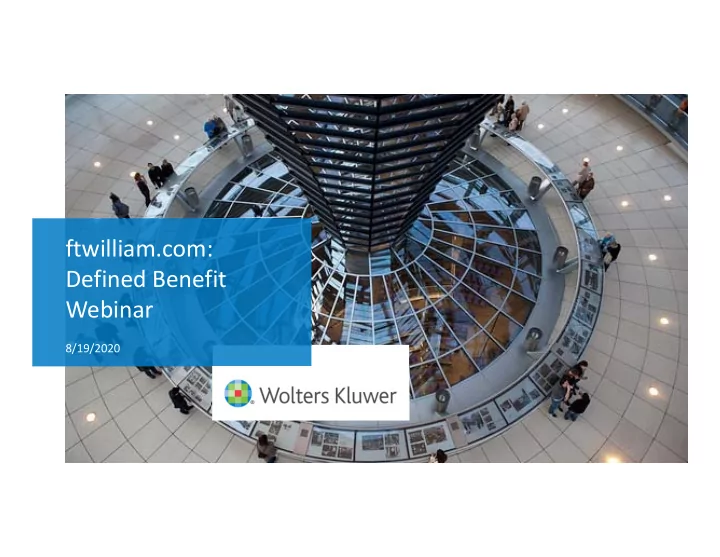

ftwilliam.com: Defined Benefit Webinar 8/19/2020
Speakers and Agenda Joe Kleinrichert – Senior Technology Project & Program Manager Demo of ftwilliam.com’s new Defined Benefit Proposal module and preview of the full Defined Benefit Valuation software that will be available later this year Charles Brown – Consulting Actuary How to leverage defined benefit plans to fully take advantage of the new SECURE Act sales strategies, such as post year‐end plan adoptions and safe harbor redesigns. 2
Agenda Safe harbor redesign strategies Retroactive adoption strategies Why defined benefit / cash balance plans? 3
Safe Harbor Redesign Strategies Old law – a plan must have a safe harbor design on the first day of the plan year in order to get safe harbor treatment (ADP and top heavy exemption) SECURE Act (eff. for 2020 plan years) – a plan may be amended at least 30 days before the last day of the year to be a 3% nonelective safe harbor, or Up to the last day of the following plan year to be a 4% nonelective safe harbor 4
Safe Harbor Redesign Strategies Example 1 Problem‐ A non‐safe harbor 401(k) plan is top heavy for 2020 and key employees have made deferrals, thereby triggering a 3% minimum allocation to non‐owner employees. Solution‐ Amend the plan before 12/1/2020 to be a safe harbor 3% nonelective. Key employees can now make maximum deferrals for 2020 without refunds. Plus, non‐owner Highly Compensated Employees can be excluded from the safe harbor contribution. (Note that any non‐Safe Harbor contribution allocation will again trigger top heavy minimums) 5
Safe Harbor Redesign Strategies Example 2 Problem‐ It is January of 2021. The owner’s CPA tells them that 2020 was a very good year and they need deductions. They have a non‐safe harbor 401(k) plan and are getting ADP refunds. Solution‐ Amend the plan to be a safe harbor 4% nonelective for 2020. This stops ADP refunds. The 4% nonelective contribution counts toward the gateway for nondiscrimination testing, so the owner can potentially get an additional 8% profit sharing (total 12% with safe harbor) without allocating anything additional to the NHCEs. 6
Retroactive Adoption Strategies Old law – a plan must be adopted no later than the last day of a plan sponsor’s tax year to get a deduction for contributions SECURE Act (eff. for 2020 tax year) – certain types of plans may be adopted retroactive to the prior tax year as late as the tax filing due date (including extensions) Profit sharing Defined benefit / cash balance Plans can be retroactively adopted for 2020 as late as 9/15/2021? Most likely a big surge from January – March 2021 7
Retroactive Adoption Strategies Before 2020 a SEP IRA was the only option after year‐end SEP IRAs have many disadvantages Pro‐rata or integrated contribution allocations No vesting schedule No distribution restrictions New law should result in adoption of profit sharing and DB/DC combinations over SEPs 8
SEP IRA SEP IRA Age HCE Comp Contribution % Owner 58 Yes 200,000 50,000 25.00% Employee 40 No 60,000 15,000 25.00% Employee 25 No 30,000 7,500 25.00% Employee 55 No 45,000 11,250 25.00% Employee 32 No 40,000 10,000 25.00% Totals 375,000 93,750 Results: Total tax deduction 93,750 Amount to Owner 50,000 Amount to Non‐Owners 43,750 Percent to Owner 53.33% 9
Cross‐Tested Profit Sharing Plan Profit Sharing Age HCE Comp Contribution % Owner 58 Yes 200,000 57,000 28.50% Employee 40 No 60,000 3,000 5.00% Employee 25 No 30,000 1,500 5.00% Employee 55 No 45,000 2,250 5.00% Employee 32 No 40,000 2,000 5.00% Totals 375,000 65,750 Results: Total tax deduction 65,750 Amount to Owner 57,000 Amount to Non‐Owners 8,750 Percent to Owner 86.69% 10
Profit Sharing and Cash Balance Plan Profit Sharing Cash Balance Age HCE Comp Contribution % Contribution % Total Owner 58 Yes 200,000 9,375 4.69% 130,000 65.00% 139,375 Employee 40 No 60,000 4,500 7.50% 500 0.83% 5,000 Employee 25 No 30,000 2,250 7.50% 500 1.67% 2,750 Employee 55 No 45,000 3,375 7.50% 500 1.11% 3,875 Employee 32 No 40,000 3,000 7.50% 500 1.25% 3,500 Totals 375,000 22,500 132,000 154,500 Results: Total tax deduction 154,500 Amount to Owner 139,375 Amount to Non‐Owners 15,125 Percent to Owner 90.21% 11
Retroactive Plan Options for 2020 Cross‐Tested PS/CB SEP IRA Profit Sharing Combination Total tax deduction 93,750 65,750 154,500 Amount to Owner 50,000 57,000 139,375 Amount to Non‐Owners 43,750 8,750 15,125 Percent to Owner 53.33% 86.69% 90.21% 12
Why Defined Benefit / Cash Balance Plans? Higher contribution limits Deductions based on benefits, not 25% of compensation RMDs based on vested benefit, not total account balance Owner over age 72 can generally delay RMDs for three years from start of plan Ability to combine with 401(k) and profit sharing plans for testing 13
Key Points The SECURE Act added options that allow the retroactive adoption or redesign or plan arrangements late into the following year. Consultants should be aware of how to employ these strategies for the benefit of new or existing clients. Defined benefit plans (cash balance and traditional) are often necessary to fully take advantage of these opportunities. 14
Recommend
More recommend